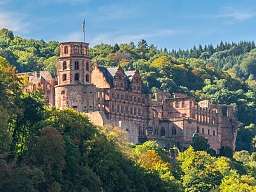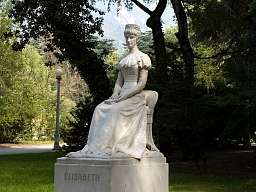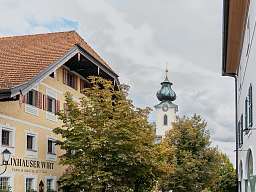Romantik Blog
Time Travel through Central Germany: From Eisenach to Pirna
In many German cities, history is almost tangible. Monuments, museums or even streets remind us of times long past and the achievements of the past. On the Time Travel Route through Central Germany, you will discover exciting stories and marvel at impressive monuments from Eisenach to Pirna. The route takes you along charming little towns and invites you to immerse yourself in the past. Of course, the individual stops are already worthwhile for a nice day trip.
1ST STOP: EISENACH
Our first stop along the Time Travel Route promises history at its best: Eisenach's most famous sight towers gracefully over the town: Wartburg Castle. It once provided refuge for Martin Luther and still serves as a reminder of the Reformation. Some 300 years later, the student Wartburg festivals count as crucial gatherings for the German unification movement of the 19th century. Today, visitors marvel at the castle's impressive rooms and learn more about its history. Below the castle, Eisenach's listed old town awaits with remains of the defensive wall, the Renaissance-era town hall and the house where Johann Sebastian Bach was born, built in 1456 and now home to one of the largest music museums in the country.
2ND STOP: WEIMAR
The great names of the past, such as Goethe, Schiller, Bach or Liszt, always resonate in this residential city in the heart of Europe. Spacious parks, narrow streets, poets' houses, museums and castles all come together here in one place and bear witness to European cultural history, which has rightly been awarded the title of World Heritage Site by UNSECO. Part of the UNESCO World Heritage Site "Classical Weimar" is also the Duchess Anna Amalia Library, which impresses with its famous rococo hall. You can also find inspiration at the Park an der Ilm, where Goethe's home is located. Works such as the ballad "Erlkönig" as well as the poem "To the Moon" were written here.
3RD STOP: ZWICKAU
Car enthusiasts will discover the origins of Audi in Zwickau: it was here that August Horch founded the August Horch Motorenwagenwerke in 1904, which eventually merged with other car brands after the Second World War and laid the foundations for Audi. In the August Horch Museum you can discover the impressive former production halls with historical small and large exhibits on 6,500 square metres. Zwickau is also particularly proud of the city's son: the famous composer Robert Schumann was born here on the main market square in 1810. In Schumann's birthplace you can still discover original furniture as well as historic keyboard instruments.
Hotel tips:
For wellness fans, there is a real highlight near Zwickau: the Romantik Hotel Schwanefeld is home to one of the most beautiful SPAs in central Germany and pampers you on four floors with a heated outdoor pool, extensive sauna world and beauty centre. In addition to the in-house restaurant, the hotel's own chocolate factory also provides moments of pleasure. Enjoy and relax here on the outskirts of the small town of Meerane in the heart of Saxony's Castle and Burgenland region.
4TH STOP: CHEMNITZ
Among art lovers, Chemnitz has long since established itself as a centre for modern art. Exhibitions of international, modern works of art by well-known artists of the 19th and 20th centuries, such as Caspar David Friedrich, are a particular contribution to this. Among the largest civic collections in Germany are the Museum Gunzenhauser and the Kunstsammlungen am Theaterplatz. In addition to art, the city also boasts an impressive monument: at 13 metres high, the Karl Marx Monument is the second largest portrait bust in the world.
5. STOP: MEISSEN
Claiming to be able to produce gold, the alchemist Johann Friedrich Böttger invented white gold - Europe's first porcelain - in 1708. Augustus the Strong then founded today's Meissen Porcelain Manufactory in 1710, which is still famous all over the world. The show workshop shows visitors everything about the production of porcelain step by step. The museum also presents impressive works of art made of porcelain and historical service. In addition to a visit to the manufactory, it is also worth visiting Meissen Castle Hill with Albrechtsburg Castle. There you can enjoy a fantastic view of the Elbe valley and explore the late Gothic castle.
Hotel Tip:
Located right next to Albrechtsburg Castle and Meissen Cathedral, the Romantik Hotel Burgkeller & Residenz Kerstinghaus awaits you above the rooftops of the city. In the royal Saxon Burgkeller you reside in a quiet location in stylish rooms and enjoy the culinary diversity of the house.
6TH STOP: DRESDEN
In the capital of Saxony, a great selection of sights awaits you, which together blend to create a fantastic backdrop. Dresden is characterised by a long and exciting history and delights with fascinating buildings of different architectural styles. In the heart of the old town, the Frauenkirche (Church of Our Lady) on Dresden's Neumarkt awaits you. The baroque church from the 18th century was rebuilt after the Second World War and has since been regarded as a symbol of reconciliation. The baroque style of the Catholic Hofkirche in the old town is also a delight. Dresden's Semper Opera House is an impressive building that combines architectural styles from the Renaissance, Neo-Baroque and Corinthian order. From the Hausmann Tower in the Residence Palace you can catch a fabulous view of the Theatre Square and the Semper Opera House. Dresden's 12th-century Zwinger houses historically valuable buildings and gardens as well as the Old Masters Picture Gallery, where works of art from the 15th to 18th centuries can be admired. The Brühlsche Terrasse promenade, whose origins date back to the 16th century, is also located directly in the Old Town. The Brühlsche Terrasse invites you to relax after an extensive sightseeing tour.
Hotel Tip:
In one of the oldest mansions in Saxony, the Romantik Hotel Bülow Residenz welcomes you in the heart of Dresden's Baroque quarter. Here you will stay in elegant rooms and suites and enjoy the charming style of the house with an extensive breakfast in the covered inner courtyard or in the baroque breakfast restaurant.
7. STOP: PIRNA
In Pirna, a cosy, historic old town awaits you with charming shops, cafés and restaurants that invite you to linger. For history fans, a visit to the GDR Museum is worthwhile. There you can take a look back at daily life in the GDR and learn all the background information on more than 2000 square metres. In Pirna you will also find the Richard Wagner Museum in the Lohengrinhaus. This was once the setting for his most successful opera, Lohengrin, which he composed during a summer holiday in 1846. Wagner's life's work is comprehensively recorded here and can be experienced in rooms from the time.
Hotel Tip:
The Romantik Hotel Deutsches Haus in Pirna welcomes you directly in the medieval old town. You will feel at home in the comfortable rooms. In the in-house restaurants you will be spoilt with regional and international cuisine and enjoy the matching wines from the well-stocked wine cellar.
Post your comment
Comments
No one has commented on this page yet.
RSS feed for comments on this page RSS feed for all comments


